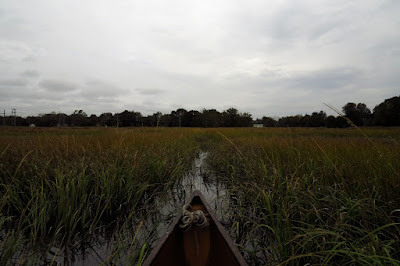I'm not more than 50 yards from the put in when I have my first critter sighting. A hundred yards up the East River a Harrier flies low, crossing the river and then crossing the entire lower marsh at an altitude of no more than 4 ft. This is how Harriers hunt - terrain masking. It ignores a flock of a dozen Great Egrets and I lose track of it. But then, a flock of smaller shore birds pops up way over by the first bend in the Neck River and I sight the Harrier again. It meanders a couple times and then follows the Neck River upstream and I lose it again. When I turn that first bend in the Neck River, I spot it again. It is all the way back at the East River, still flying low.
The tide is crested and the current almost nonexistent. In fact, the water is a good 3 or 4 inches higher than predicted due to atmospherics. We have a minor storm coming in this evening and little surges are pretty obvious in low marshes.
 |
| Yellow Legs |
I pass through the Sneak with ease as it is full up and full width so the tight turns in the channel are easy to get the canoe around. The spartina is turning color of course, but if one looks close, it is the glasswort that steals the show. It has turned to a brilliant rosy-pink-red.
I spot a few flocks of Yellow Legs in the marsh, they are becoming common again having migrated from a bit north of here. The Willets are all gone.
 |
| Glasswort |
I decide to explore a bit of the side channels in the upper marsh rather than push on up to the forest. On the return I take the Long Cut, a narrow passage that takes one from the East River to high up in Bailey Creek. I've never seen anyone else back here. It is a reliable place to spot migrating ducks and it doesn't fail today. I flush a half dozen Mallards and fifteen to twenty of the shyer Black Ducks.
 |
| The Long Cut |
Back in Bailey Creek I pick up a quick ebb current and have an easy paddle out.
































